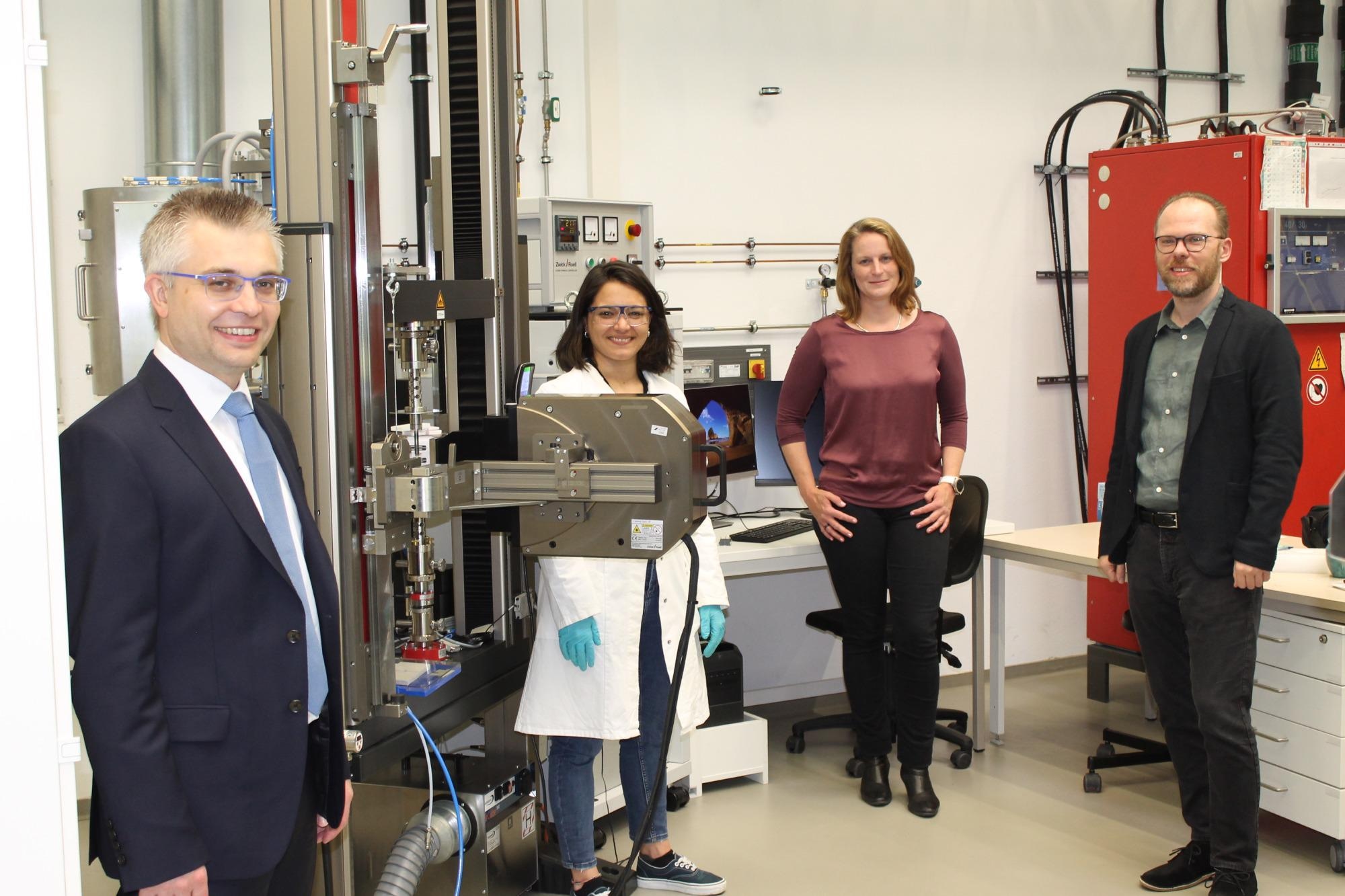Reviewed by Alex SmithSep 2 2021
Researchers at the University of Bayreuth advance the study on high-temperature electrolysis (HTEL) as a section of the hydrogen flagship program supported by the Federal Ministry of Education and Research (BMBF).
 Joint research on high-temperature electrolysis at the Ceramic Materials Engineering research group: Prof. Dr-Ing. Stefan Schafföner, Ilaria Bombarda MSc, Dr-Ing. Carolin Sitzmann, and Dr rer. nat. Nico Langhof (from left to right). Image Credit: UBT / Christian Wißle.
Joint research on high-temperature electrolysis at the Ceramic Materials Engineering research group: Prof. Dr-Ing. Stefan Schafföner, Ilaria Bombarda MSc, Dr-Ing. Carolin Sitzmann, and Dr rer. nat. Nico Langhof (from left to right). Image Credit: UBT / Christian Wißle.
The target of the H₂Giga project is the research, development and industrial production of high-performance, low-cost electrolyzers to fulfill the demand for green hydrogen in Germany. One of the seven “scale-up projects” in H₂Giga is the H₂Giga project “HTs: HTEL Stacks — Ready for Gigawatt.” The project is coordinated by a company called Sunfire. Financial support of over €950,000 has been awarded to the Chair of Ceramic Materials Engineering for almost four years.
Green hydrogen is capable of storing huge volumes of sustainably produced energy and can be transported over long distances. This makes it a key factor for future energy supply. It is predicted that Germany’s needs alone will range at a volume of several hundred million tonnes per year.
To fulfill this demand, robust, efficient and cost-effective electrolyzers are required to split water molecules, utilizing electrical energy from sustainable sources, to produce hydrogen.
The electrolyzers need to be produced in huge industrial volumes and should address the European Union’s hydrogen strategy target of 40 gigawatts of electrolysis capacity by 2030.
HTEL seems to certainly be a potential technology for the production of green hydrogen. HTEL cells interlinked in series, known as HTEL stacks, act as electrolyzers. However, to produce large-scale HTEL cells and stacks in the future, more involvement in research and development is needed. The measures cover material costs, service life, new technology for stack manufacturing, efficiency, and their use in producing hydrogen in required high quantities.
This is exactly what the H₂Giga project “HTs: HTEL Stacks — Ready for Gigawatt” is working on. The Chair of Ceramic Materials Engineering at the University of Bayreuth is responsible for this remarkable research and advancement in this collaborative project. The new electrolyzer cells and the previously developed cells are to be analyzed for their thermomechanical and microstructure characteristics.
It is certainly important to maintain the cell strength at high temperatures ranging up to 850 °C. Prediction of the aging process and developing plans for longer life are possible only when the relationship between thermomechanical and microstructure properties are scientifically studied.
With the special competencies and many years of research experience we have gained in earlier projects on fuel cells and the characterisation of very thin ceramic films, we will be able to make important contributions to a sustainable energy supply based on hydrogen.
Dr.-Ing. Stefan Schafföner, Professor and Chair of Ceramic Materials Engineering, University of Bayreuth
The research will receive funding retroactively from May 1st, 2021, to March 31st, 2025.
The future works of the University of Bayreuth will involve experimental research methods such as light and scanning electron microscopy, non-destructive pulse excitation technology and X-ray diffraction. Mechanical parameters on the ceramic thin films will be quantified at a range of up to 850 °C using the ring-on-ring tests and tensile tests using a laser extensometer.
The new and distinctive high-temperature universal testing machine that was financially supported by the German Research Foundation (DFG) and the TechnologieAllianzOberfranken at the end of 2020 will be used for this purpose.
Further to the experimental work, simulations would be run using the finite element method to quantify the service life of HTEL cells.
Considering the industrial implementation of the HTEL stacks, the Chair of Ceramic Materials will work together with numerous partners from academia and industry in the joint project “HTs: HTEL Stacks — Ready for Gigawatt.” The overall organizational management of the collaborative project is in the hands of Sunfire GmbH in Dresden.